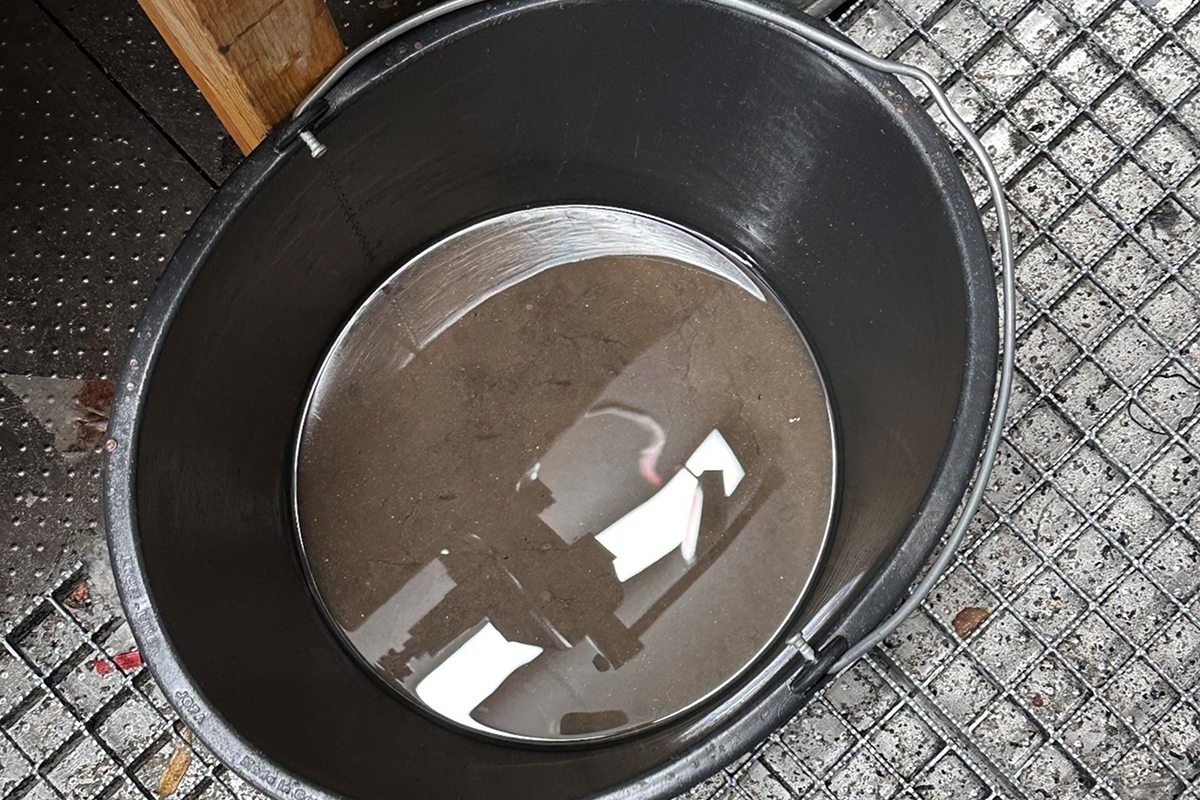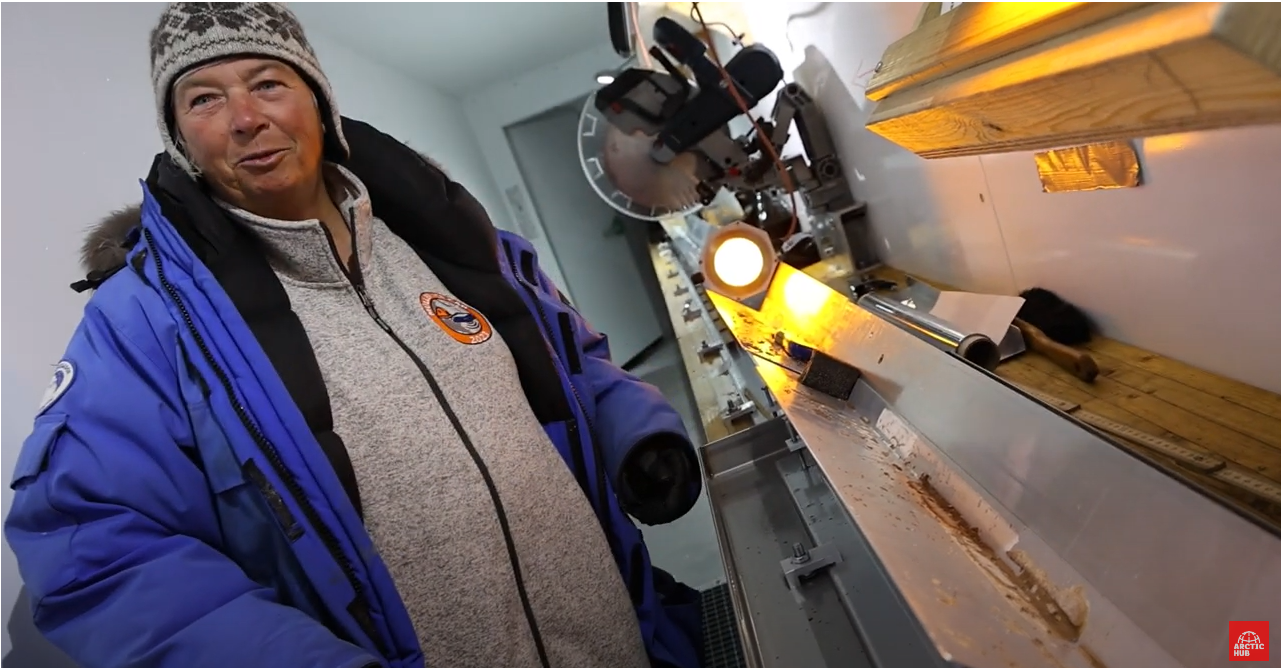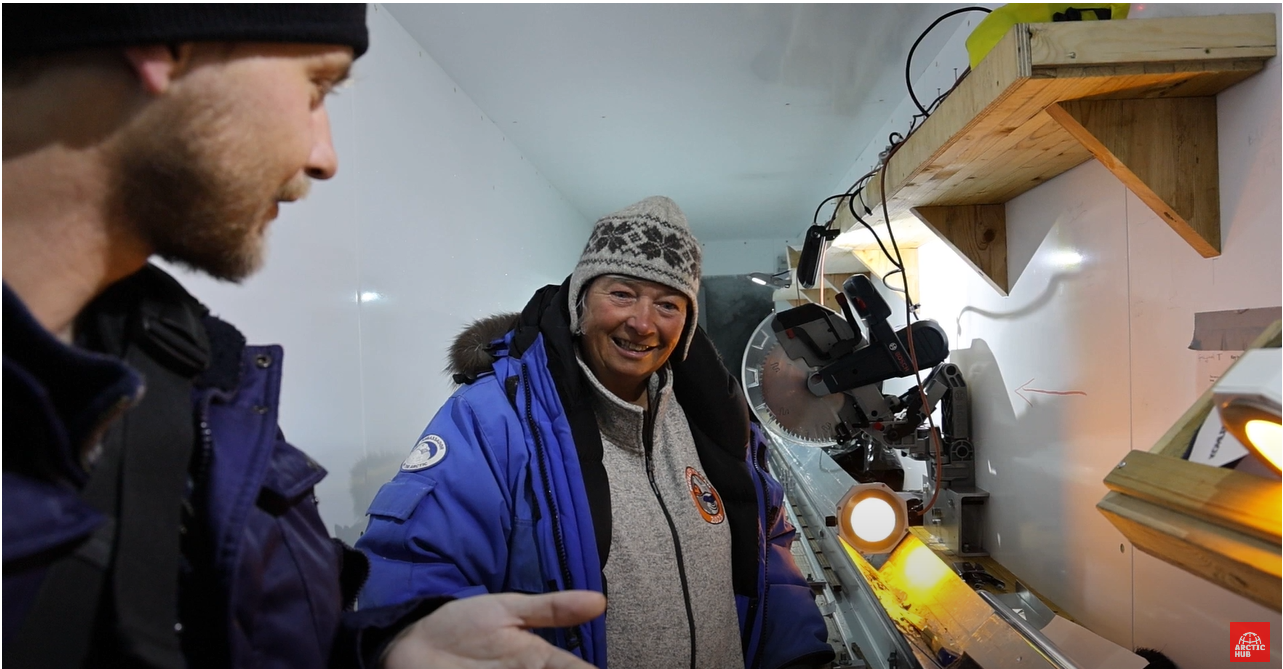Scientists make surprising discovery at the bottom of the Greenland ice sheet
Join Arctic Hub for a visit to the research station at the 75th parallel, where scientists recently made a historic discovery.
By Sara Kirstine Hald
Ice, ice and more ice. Everywhere you turn, there is ice as far as the eye can see. We are in the middle of the ice sheet. In the middle of nowhere.
… and yet, scattered across the mass of ice a pile of red tents, a row of poles with fluttering flags, a handful of snowmobiles and a large, angular dome appear. Together, these entities make up a mobile research station, which constitutes the framework for the international research project EastGRIP – East Greenland Ice-Core Project, that has just had a significant breakthrough.
Since 2016, interrupted only by the pandemic, EastGRIP has been drilling through the 2,670 meters of ice that surrounds the base. And on the day before our visit, they succeeded; for the first time ever, scientists managed to reach the bottom of a so-called ice stream. Their findings may provide new insights into the climate of the past – and the future.
We’ve made a little behind the scenes video from our visit. Watch it here.

The EastGRIP research base is located at the 75th parallel.
Source: Google Maps
The ice sheet is a journal of the planet’s climate
Drilling through almost three kilometers of ice is quite the feat, but why do it? What is in it for us?
The simple answer is knowledge. And lots of it.
Looking at ice cores can tell us a lot of things. For example, the specific ice core of the EastGRIP project can tell us about the earth’s climate and evolution over the past 120,000 years.
The information is found, among other things, in impurities and air bubbles in the ice, which when analyzed can reveal the composition of the atmosphere at a given time. The sulphate content in the ice sheet can be traced to volcanic eruptions, just as scientists can track changes in the ice corresponding to the industrial development.
The ice cores contain a wealth of information that can help us understand the past, and, in particular, the climate of the past. At the same time, the findings at EastGRIP point to the future.

The ice core drilling takes place in an underground – or “under-snow” – drilling hall.
Photo: Sara Kirstine Hald
Newfound knowledge about ice streams
The EastGRIP ice core measuring 2,670 meters was drilled in an ice stream – i.e., ice that flows faster than the surrounding ice sheet and calves into the fjords, where it becomes icebergs. The ice stream thus account for a large part of the ice loss occurring in Greenland. Just about half, actually. Still, not much was known about them – until now.
The day before our visit, the researchers reached all the way through the ice and hit… mud.
“We could see that the entire ice stream flows on a layer of mud at the bottom. This was not known before,” says Professor Dorthe Dahl-Jensen, who leads the research at EastGRIP.

The wet mud has been hidden under the 120,000-year-old ice of Greenland.
Photo: Sara Kirstine Hald
The theory is that the wet mud acts as quicksand, enabling the large block of ice to slide smoothly across the bedrock. So, you have to imagine a large block of ice breaking away from the rest of the ice sheet and sliding towards the fjords on mudflats.
“Until now, it was thought that ice streams had shifts down through the ice, but at EastGRIP we have seen that the entire mass – totaling 2,670 meters of ice – flows as a single block at a speed of 58 meters per year,” says Dorthe Dahl-Jensen.
She calls the finding ‘exceptional’ and has no doubts about its significance: “It will change climate models because it changes our basic understanding of how ice moves,” says Dorthe Dahl-Jensen.
The discovery of mud has given researchers new knowledge about how the ice stream moves. Hear Dorthe Dahl-Jensen talk about this in the video below.
The ice core gives us a better idea of future sea level rise
The global sea level is rising, partly due to human-caused climate change. Ice loss from the Greenland ice sheet, including ice streams, contributes significantly to these increases.
The findings from EastGRIP not only provide us with new knowledge about the ebb and flow of ice streams. It also gives us new knowledge about the source of half of Greenland’s ice loss, which leads to sea level rise all over the world.
Concretely, the new knowledge may contribute to more accurate forecasts of future sea level rise.
“The fact that the ice does not shift, but slides like a block on mud, is going to improve sea level predictions in the future with the help of modified models,” says Dorthe Dahl-Jensen.
“Until now, it was thought that ice flows had shifts down through the ice, but at EastGRIP we have seen that the entire mass – totaling 2,670 meters of ice – flows as a single block at a speed of 58 meters per year.”
– Dorthe Dahl-Jensen
We can future-proof Venice, Copenhagen and Miami
Although new knowledge about ice streams does not allow us to stop sea level rise, it does make it possible to prepare for them. For example, rising water levels can and, indeed, should be kept in mind in new construction projects. Now, initiatives can be launched to protect vulnerable cities and coasts.
The whole point of predicting sea level rise is that it allows us to prepare for it. If we know roughly how the sea level will rise in the coming decades, we are better equipped to future-proof the numerous cities, areas and countries that will be affected by the increased water volumes.
Cities such as Venice, Copenhagen and Miami, to name just a few, are affected by sea-level rise. As are numerous Asian countries such as Vietnam, Bangladesh, and India. The more accurate forecasts of the sea level rise, the better chances are of protecting these areas.
Wondering why the mud isn’t frozen solid? Dorthe Dahl-Jensen explains why in the video below.
The ice streams have a direct impact on Greenland’s fisheries
The new knowledge from EastGRIP is important in a global perspective. Locally, in Greenland, it can also prove to be of great importance because the ice streams supply the sea around Greenland with nutrients that are essential to fisheries.
By learning more about the ice streams and their future, we can also learn more about the future of the fisheries around Greenland. At the same time, the loss of ice from the ice sheet naturally affects Greenlandic waters into which the ice from the ice streams is bound to end up. The findings can therefore have an impact both locally in Greenland and on the rest of the world.
The analyses of the ice cores will start in the autumn of 2023, and it is estimated that the results will be ready within a year. ■
Join us behind the scenes in the video below:
About the EastGRIP camp
- EastGRIP is a mobile research station. The main building, called the Dome, is placed on skis, while the rest of the buildings and equipment are placed on sleds.
- The entire camp can be towed to a new location on the ice sheet using belt vehicles.
- People, materials and machinery are transported to the base in Hercules aircraft owned by the US National Science Foundation. They are flown by the US Air National Guard.
- The drilling takes place in an underground drill hall. It is created by placing balloons with a diameter of five meters into trenches in the snow. Subsequently, snow is blown on top, and after a few days, the balloons are emptied of air, leaving behind a drilling hall of snow and ice.
About the EastGRIP project
- EastGRIP is an international research collaboration with participants from 14 nations.
- The logistics are carried out by the University of Copenhagen and the US National Science Foundation.
- Fifty-five per cent of the research project’s budget comes from Denmark. The project is supported by the AP Møller Foundation, the Villum Foundation and the University of Copenhagen among others.

